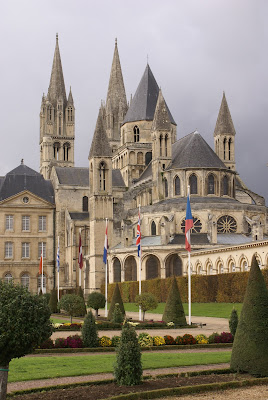Grant is out of school this week on fall break. Unfortunately, Lori is in the States for work so Grant & I unloaded Graber at the kennel and headed for France...Boys' week in Normandy for good food, beautiful scenery, WWII beaches and Mont St Michel.
It also turns out to be a week of French strikes which have closed 9 of their 10 oil refineries and are causing fuel shortages. We were able to fill up on gasoline today, but there was no diesel (fuel of choice for many Europeans). One station in the town of Caen had a line of cars two blocks long waiting for fuel. We think we have enough gas to make it back to the Sechler home in Belgium. If not, we'll call Carol and she can run a fuel sortie down to save us.
And, I'll also mention that this blog is being brought to you live, thanks to Grant's Mac Book and the free WiFi at Hotel L'Absinthe (which is French for "dark hallways").
But before France we stopped in Belgium to learn about the first war to end all wars. We visited the town of Ieper, or Ypres as it was known during WWI. I find both names equally difficult to pronounce. Like many towns in this region, Ypres was literally leveled during heavy fighting in WWI. The Germans and the Allied pushed back and forth over the same ground for four years destroying every building, tree and many of the people. Afterwards, people returned to their villages and rebuilt from the rubble. That was certainly the case in Ypres and as you can see in the pictures, they did a remarkable job.
Ypres was a successful textile town in the 13th century when the beautiful Cloth Hall was built. Building this huge structure once was a tremendous task, but having to repeat this again after WWI is remarkable. Legend has it that the town had a problem with mice getting into the cloth. To combat this issue, they procured a large number of cats. Mice problem solved; but now what to do with the cats? This being about 600 years before PETA, the townsfolk arrived at the idea of throwing the cats out the belfry of the Cloth Hall. The event is celebrated each May at the Festival of the Cats. Luckily, they now use stuffed velvet cats. (Authors note: we did stay at the Old Tom Hotel in Ypres so perhaps there is something to this cat legend).
There are many WWI memorials and cemeteries in the region. In town is the Menin Gate, a British War Memorial where the names of almost 55,000 Commonwealth soldiers who died but whose graves are unknown are inscribed on the walls. By comparison, the Vietnam War Memorial includes all US soldiers who died or are missing in action....a little over 58,000.
At Essex Farm Cemetery we saw the bunker where John McCrae wrote his famous poem, In Flanders Field. Out of respect for the Canadian and pseudo-Canadian readers of this blog I've included a picture of the Canadian Forces Memorial in Zonnebeke.
Tyne Cot Cemetery holds the graves of almost 12,000 Commonwealth soldiers (and four Germans). It also has a Memorial with the names of 35,000 soldiers that were missing after August 16, 1917 (the cut-off date for the Menin Gate). As Grant and I were walking along this memorial, we found the name of one S. Woodburn, a private from the King's Liverpool Regiment who was killed but has no known grave. Several questions arise.. was his first name Samuel? It would have been nice if the Graves Commission had included first names, but after experiencing the confusion on how to spell my father's middle name, maybe I can understand their strategy of "the fewer names to inscribe, the better". Second, are we distantly related? Tom, time to get back on the genealogy work.
Finally, we also visited the Deutscher Soldatenfriedhof, or German Cemetery. In contrast to the gleaming white British Cemeteries with large monuments, this one is also beautiful, but very subdued with many trees, markers flush in the ground and brown buildings. Over 44,000 soldiers are buried here.
I recognize that I've included many numbers here and I certainly don't mean to reduce people's deaths to numerics. But I never really knew much about WWI. My Riverdale history classes never seemed to make it to the 20th century before the school year ended. And all the war movies and books were about WWII. So the numbers helped put things into perspective, although a bleak one at that. All in all, almost 10 million soldiers died in combat during WWI and over 7 million civilians. All together that's about the same as the current population of The Netherlands. What a waste.
 |
| Menin Gate in Ypres |
 |
| British Cemetery in Ypres. Said to have the greenest lawn in Europe |
 |
| When in Belgium eat waffles...... |
 |
| .....with knorks (knife - fork combination) |
 |
| John McCrae's famous bunker |
 |
German Cemetery
|
 |
| Firing from the trenches |
 |
| O Canada! |
 |
| Who can resist rolling down a hill? |
 |
| And at the bottom is says "Known unto God" |
 |
| Tyne Cot Cemetery |
 |
| S. Woodburn, Liverpool Regiment. Pretty lucky to find this out of 35,000 names. |
 |
| Cloth Hall and Belfry in Ypres |






















































